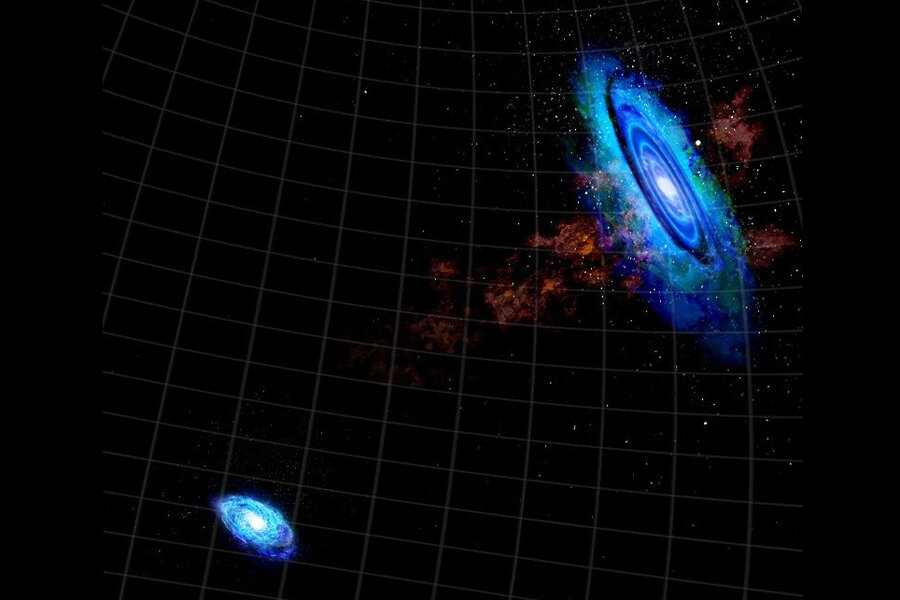Colossal hydrogen bridge between galaxies could be fuel line for new stars
Loading...
Newly published radiotelescope observations of this segment of what researchers have dubbed the “cosmic web” reveal that about half of the neutral hydrogen gas in the bridge is contained in rotating clumps the size of dwarf galaxies. Neutral hydrogen – atoms with one proton and one electron – represents the raw material for new stars.
“If this gas is being accreted by the galaxies, then we need to understand how they're doing that. That information could, in principle, help us understand how galaxies like Andromeda, like our own Milky Way, can acquire gas to form new stars,” says Spencer Wolfe, a PhD candidate in astronomy at West Virginia University and the lead scientist on the project.
Over the past decade, astronomers have come to appreciate the potential of gas between galaxies to provide fresh fuel for making stars in spiral galaxies.
Star formation in the universe appears to have peaked some 10 billion to 11 billion years ago. Stellar birthrates these days are less than 10 percent of what they were then, notes Robert Braun, an astronomer at the Australia Telescope National Facility in Epping, New South Wales.
Left to their own devices, galaxies have on average about 1 billion to 2 billion years worth of gas in the cosmic tank, a condition that has existed throughout most of the universe's history, Dr. Braun writes in an e-mail. Many of them, therefore, should have stopped forming stars billions of years ago. Moreover, the total mass of stars in the universe today is about five times higher than the amount of neutral hydrogen available 12 billion years ago, suggesting that the universe's larger inventory of ionized hydrogen kept star formation going in some way.
Researchers have identified other mechanisms for the galactic equivalent of in-flight refueling. For instance, gas gets recycled for a time through successive generations of stars. Collisions, mergers, and even near-misses between galaxies can trigger bursts of star formation. But filaments of ionized hydrogen appear to be the only features persistent enough to keep galaxies stocked with stars over billions of years of cosmic history. Somehow, within those filaments, enough of the ionized gas condenses into the neutral form to serve as new stellar nurseries.
The filament or bridge Mr. Wolfe and his team studied appears between the Milky Way's nearest neighbor, the Andromeda Galaxy, and the Triangulum Galaxy. Andromeda is some 2.5 million light-years from Earth, while the Triangulum is roughly 3 million light-years away.
The presence of neutral hydrogen in the bridge was first reported in 2004 and confirmed in follow-up observations published last year. But it's fiendishly difficult to detect. One way neutral hydrogen betrays its presence is via radio waves, with a tell-tale signal at about the same frequency that a typical cell-phone uses. But the clumps are so wispy that their radio emissions were too faint for detailed studies with the radio telescopes used in the early work.
The new observations were made with a 100-meter-wide dish at the National Radio Astronomy Observatory's Greenbank facility in West Virginia. Although it's significantly more sensitive than the radio telescopes used previously, the team still had to push it to its limits.
“We were reaching sensitivities that have never been reached before,” says Edward Shaya, an astrophysicist at the University of Maryland at College Park, and a member of the team reporting its results in Thursday's issue of the journal Nature.
Within the neutral hydrogen dispersed in the larger stream of ionized hydrogen, the team found seven blobs that range in size from about 7,800 light-years across to 20,900 light-years across and contain gas supplies that could form between 40,000 and 400,000 suns.
Some researchers had suggested that the bridge really was a tail of material pulled from Andromeda by a close encounter with the Triangulum Galaxy.
But the team notes that the close encounter is thought to have taken place a few billion years ago. The lifetime of gas clumps on the scale the team detected would have collapsed to begin making stars some 400 million years after they formed. And given the length of the bridge, it would take only about 100 million years for a blob to cross it. Instead, the team suspects that the blobs formed spontaneously from some instabilities within the gas bridge.
Such instabilities could result from the gravitational influence of a filament of dark matter – a form of matter that doesn't readily interact with other forms of matter except through its gravity. Such a filament would serve as the bridge's scaffolding. The influence of dark matter also would explain the clustering the seven clumps exhibit, the researchers posit.
Invoking filaments of ionized hydrogen as the ultimate reservoir for the stuff of new stars also helps explain the reduced productivity in today's universe, Braun adds.
"The rate of condensation of ionized to neutral matter has slowed down as a consequence of the accelerating expansion of the universe due to dark energy, which has made it increasingly difficult to capture the ionized filaments of gas," he writes.
Now that the team has identified neutral hydrogen in the bridge, "the question we haven't resolved yet is whether this is gas that's falling in or is being drawn out,” Dr. Shaya says.
Nor has the team analyzed the full length of the bridge yet.
“There could be a heck of a lot more gas out there than we are aware of,” he adds.
If such bridges and clumps are common, they could help explain why stars continue to form in galaxies that, if left to their own resources, should have run out of gas long ago. But trying to find out how common is a tough task. The bridge is extraordinarily faint, while the galaxies at each end are the closest large spirals in the Milky Way's neighborhood.
“We have no hope of observing at this level for all the other galaxies,” he says.







